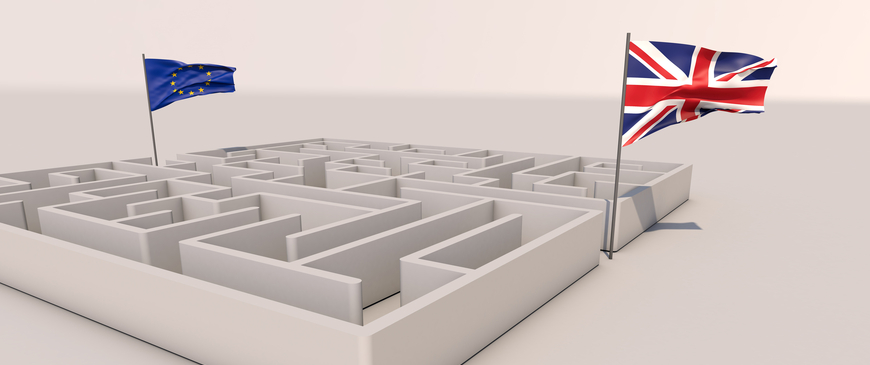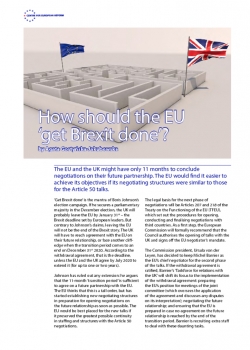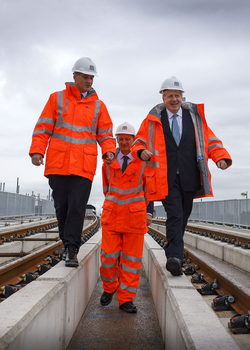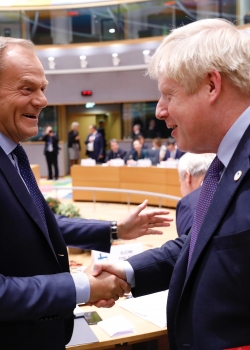
How should the EU 'get Brexit done'?
The EU and the UK might have only 11 months to conclude negotiations on their future partnership. The EU would find it easier to achieve its objectives if its negotiating structures were similar to those for the Article 50 talks.
‘Get Brexit done’ is the mantra of Boris Johnson’s election campaign. If he secures a parliamentary majority in the December election, the UK will probably leave the EU by January 31st – the Brexit deadline set by European leaders. But contrary to Johnson’s claims, leaving the EU will not be the end of the Brexit story. The UK will have to reach agreement with the EU on their future relationship, or face another cliff-edge when the transition period comes to an end on December 31st 2020. According to the withdrawal agreement, that is the deadline, unless the EU and the UK agree by July 2020 to extend it (for up to one or two years).
Johnson has ruled out any extension: he argues that the 11-month ‘transition period’ is sufficient to agree on a future partnership with the EU. The EU thinks that this is a tall order, but has started establishing new negotiating structures in preparation for opening negotiations on the future relationship as soon as possible. The EU would be best placed for the new talks if it preserved the greatest possible continuity in staffing and structures with the Article 50 negotiations.
The legal basis for the next phase of negotiations will be Articles 207 and 218 of the Treaty on the Functioning of the EU (TFEU), which set out the procedures for opening, conducting and finalising negotiations with third countries. As a first step, the European Commission will formally recommend that the Council authorises the opening of talks with the UK and signs off the EU negotiator’s mandate.
The Commission president, Ursula von der Leyen, has decided to keep Michel Barnier as the EU’s chief negotiator for the second phase of the talks. If the withdrawal agreement is ratified, Barnier’s ‘Taskforce for relations with the UK’ will shift its focus to the implementation of the withdrawal agreement: preparing the EU’s position for meetings of the joint committee (which oversees the application of the agreement and discusses any disputes on its interpretation); negotiating the future relationship; and ensuring that the EU is prepared in case no agreement on the future relationship is reached by the end of the transition period. Barnier is recruiting extra staff to deal with these daunting tasks.
Irrespective of how many officials Barnier employs, however, 11 months is too little for the Commission to negotiate a comprehensive future partnership covering not only trade but various other policy issues. Barnier and his team will therefore prioritise negotiations in areas in which ‘no deal 2.0’ would have the biggest implications for the EU and the UK. The new task force structure suggests that trade and security will be top priorities. Barnier will co-operate in those areas with Phil Hogan, the incoming trade commissioner, Sabine Weyand, director general for trade, Josep Borrell, the incoming EU High Representative, and Helga Schmid, secretary general of the European External Action Service.
Unlike the Commission, the Council has not yet formally decided how it wants to organise itself. Normally when the EU conducts international trade negotiations, the Council relies on its Trade Policy Committee (TPC), chaired by the member-state holding the rotating Council presidency. But in the Article 50 negotiations Didier Seeuws, formerly chef de cabinet to then European Council President Herman Van Rompuy, was made chair of the ‘Ad hoc working party on Article 50’, composed of delegates from the 27 member-states. This group facilitated the flow of information between capitals and Barnier, and allowed member-states to raise their concerns about the negotiations. When the group discussed contingency planning for no deal, member-states were allowed to send an extra official with sectoral expertise. Although the UK is scheduled to become a third country on February 1st, many member-states believe that the model used during these discussions should be retained for phase two, at least for the next 11 months, provided that Seeuws, with his negotiation skills and willingness to reconcile differences between the 27 and the Commission, remains chair.
MEPs, who will need to approve the final deal with the UK, could also be useful to the Commission in negotiating a deal. When the British negotiating team questioned any of the EU’s ‘divorce’ terms, Barnier was able to threaten that any amendment could lead to the European Parliament vetoing the final deal. The European Parliament became more fragmented after the May election, but pro-European parties will insist on a robust defence of the EU’s interests in the second phase. MEPs could thus be Barnier’s ‘bad cop’ in the negotiations on the future relationship. Throughout the Article 50 negotiations, Barnier worked closely with the European Parliament’s Brexit steering group, composed of the leaders of the parliament’s biggest political blocs and the chair of the constitutional affairs committee. In the second phase the steering group might also include the chairs of the foreign affairs and international trade committees, among others.
Guy Verhofstadt, who currently chairs the group, aspires to chair Von der Leyen’s promised conference on the future of Europe; so the European Parliament may need a new Brexit co-ordinator.
The limited time frame that Johnson has set for the negotiations makes it difficult to reach any EU-UK deal much beyond a bare bones free trade agreement. The greater the time pressure, the less room there will be for divisions among the 27. But even so, one cannot entirely exclude squabbles among capitals either over the scope of the mandate or Barnier’s approach to the talks. For example, when member-states discussed no-deal contingency legislation on road freight, Poland’s push to allow road freight between the EU and UK to continue without disruption temporarily was initially opposed by Germany, which is a transit country for Polish lorries. But with the help of Seeuws a compromise was eventually struck among the member-states. It would be easier for the EU to reconcile any future differences of opinion among the member-states if it could retain the familiar negotiating structures and their experienced personnel.
The EU would also benefit from maintaining its ‘full transparency policy’, whereby the Commission publishes all its negotiating documents and regularly exchanges views with the 27 EU governments, national parliaments and other stakeholders. In the Article 50 talks, the EU’s willingness to set out its objectives publicly kept the UK on the defensive, and left the impression, whether fairly or not, that the UK was working to an agenda set by the EU. Such an approach in the second phase of the negotiations would also make it harder for the UK to attempt to agree side deals with member-states if the prospects for finalising the EU-UK negotiations on time were bleak, or to blame the EU for the collapse of talks.
Agata Gostyńska-Jakubowska is a senior research fellow at the Centre for European Reform.



